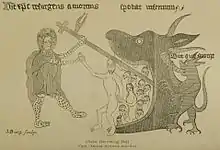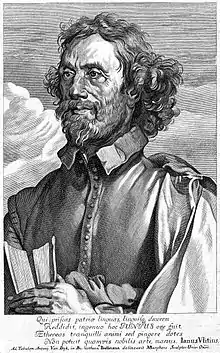
Michael Burghers (b. c.1647/8 – 1727) was a Dutch illustrator and artist of the 17th century, who spent most of his career in England. He was commissioned to create maps, estate plans, and illustrations of stately houses, by the English aristocracy.

Biography
Michael Burghers was a Dutch engraver, who settled in England on the taking of Utrecht by Louis XIV. He lived mostly at Oxford, and on several of his plates he added Academiae Oxon. calcographus after his name.[1]
He was the author of a book, Ancient Mysteries Described, which was reprinted into the early 19th century.
Describing Burghers' style, Joseph Strutt wrote
He worked almost wholly with the graver, in a stiff, tasteless style, without genius, or knowledge of the art of design. His drawing, when he attempted to draw the naked figure is wholly defective. He has, though, painfully preserved many ancient reliques, the originals of which are now lost.[2]
Strutt thought that Burghers' best plates were his copies after Claude Mellan, and his topographical work, much of it for the antiquary Thomas Hearne.[2]
He died on 10 January 1726–7.[3]
Works
From 1676 Burghers engraved the plates for the Almanacks of the university. His most esteemed prints are his antiquities, ruins of abbeys, and other curiosities. He also engraved several portraits and plates for the classics.[1] They include:[4]
Book illustrations

- Illustrations to Dr. Plot's Natural History of Oxfordshire. Being an Essay towards the Natural History of England. 1677.[5]
- Illustrations to Robert Plot's Natural History of Staffordshire. 1686.[5] (pictured)
- Illustrations to Dr. White Kennet's History of Ambroseden.
- Illustrations to the fourth edition of Milton's Paradise Lost, published by Jacob Tonson. Burghers engraved eleven of the twelve plates; seven of them after drawings by J.B. de Medina; the drawings for the others may have been by Henry Aldrich.[6]
- Engravings of ichnographies in Browne Willis's Survey of York, Durham, Carlisle, Chester, Man, Lichfield, Hereford, Worcester, Gloucester, and Bristol Cathedrals. 1727. The exception is Man.
Other plates
- William Somner, the antiquary; after van Dyck (pictured)
- Franciscus Junius; after the same.
- John Barefoot, letter doctor to the University. 1681.
- Illustrated Plate in Philosophical Transactions, 1684, vol 14.
- Head of James II for an Almanack. 1686.
- Anthony à Wood; in a niche; his only mezzotint.
- King Alfred; from a MS. in the Bodleian Library.
- Sir Thomas Bodley; in the corners of the plate are the heads of the other benefactors of the Bodleian Library; William, Earl of Pembroke, Archbishop Laud, Sir Kenelm Digby, and John Selden.[1] The plate was published as a frontispiece to a catalogue of manuscripts in the library.[2]
- Timothy Hatton, provost of Queen's College.
- Dr. Wallis. 1699.
- Sir Thomas Wyat.
- John Baliol.
- Devorguilla, his spouse.
- Dr. Ratcliff.
- The Visage of Christ; engraved in the manner of Claude Mellan, with a single line.
Notes
- 1 2 3 Bryan 1886
- 1 2 3 Strutt, Joseph (1786). "Michael Burghers". A Biographical Dictionary Containing All the Engravers, From the Earliest Period of the Art of Engraving to the Present Day. Vol. 1. London: Robert Faulder. p. 161.
- ↑ Fagan, Louis Alexander (1886). . In Stephen, Leslie (ed.). Dictionary of National Biography. Vol. 7. London: Smith, Elder & Co.
- ↑ From Bryan 1886–9 unless otherwise indicated.
- 1 2 Seccombe, Thomas (1896). "Plot, Robert". In Lee, Sidney (ed.). Dictionary of National Biography. Vol. 45. London: Smith, Elder & Co.
- ↑ Boorsch, Suzanne. "The 1688 Paradise Lost and Dr. Aldrich" (PDF). Metropolitan Museum of Art. Retrieved 20 October 2013. The one plate not engraved by Burghers was by P.P. Bouche after Bernard Lens.
References
 This article incorporates text from a publication now in the public domain: Bryan, Michael (1886). "Burghers, Michael". In Graves, Robert Edmund (ed.). Bryan's Dictionary of Painters and Engravers (A–K). Vol. I (3rd ed.). London: George Bell & Sons.
This article incorporates text from a publication now in the public domain: Bryan, Michael (1886). "Burghers, Michael". In Graves, Robert Edmund (ed.). Bryan's Dictionary of Painters and Engravers (A–K). Vol. I (3rd ed.). London: George Bell & Sons.